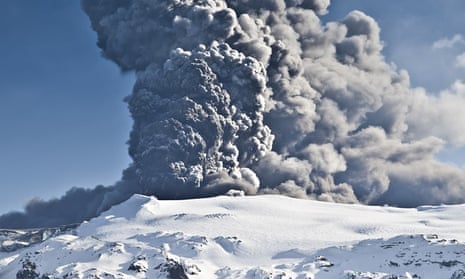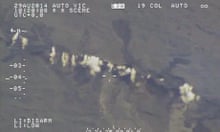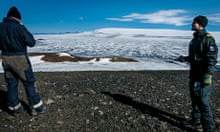The heightened seismic activity at the Bárðarbunga volcano in Iceland, which began on 16 August, shows no sign of abating. The Icelandic Met Office has issued an “orange” flight warning, the second highest alert on its scale. This means Bárðarbunga, which is part of a large volcano system underneath the several hundred metre thick ice of the Vatnajokull glacier, is showing “escalating unrest with increased potential of eruption”.
A small subglacial eruption is thought to have occurred on 23 August, causing the alert to be elevated temporarily to red, but the subsequent lack of any signs of melted ice revealed this to be a false alarm.
While there is a remote possibility of a huge eruption, which would have impacts far beyond Iceland, this is unlikely, and we should also not see any repeat of the massive airspace closure in Europe in 2010, the biggest since the second world war, following the eruption of Eyjafjallajökull volcano.
The locations of earthquakes and the movement of GPS instruments installed around Bárðarbunga show that a vertical sheet of magma has been growing in a northeasterly direction at several kilometres depth, and has now reached well beyond the ice cap.
This type of activity is not unusual in Iceland, which has around 30 active volcanoes. There are eruptions, of various magnitudes, roughly every three years on average as the European and North American tectonic plates move apart from each other at two centimetres a year, stretching the crust. So it is entirely possible that Bardarbunga may not erupt at all for the foreseeable future.
The arrival of new magma around Bárðarbunga is relaxing this stretching, and creating new crust. Whether the magma continues to the surface depends on how much the crust is currently stretched, and how much more magma is supplied.
If magma does make it through to the top of the crust, this could now occur in an area free of ice, which would not lead to a major ash-producing eruption. This is because when magma erupts under ice, it melts the ice and the interactions between the liquid water and magma fragments the molten rock to make ash. Volcanic ash is fragmented magma.
If an eruption occurs beneath the ice cap, however, there is still a matter of hundreds of metres of ice to melt through before any ash can reach the atmosphere. Although this can happen in a matter of hours in the right circumstances. The more immediate effect would be large floods from the meltwater, with potential risk to human life. The authorities in Iceland have therefore evacuated hundreds of people from the highlands north of the Vatnajökull glacier.
Despite the potential risks, however, there are several reasons to believe that a repeat of the airspace closure seen after the 2010 eruption of Eyjafjallajokull is unlikely. That eruption resulted in planes being grounded for almost a week, stranding millions of travellers and costing the industry a massive sum.
The ash in that case was especially fine, allowing it to stay aloft for longer. Moreover, the weather at the time also conspired against civil air authorities and travellers, with dry air and consistent northerly winds causing the ash to spread deep into Europe.
But the most significant reason not to fear a repeat of the events of 2010 is that there is no longer an aviation “zero tolerance” policy to ash. This means that aircraft are now allowed to fly in areas containing low particle concentrations, and various efforts such as a collaboration of 26 European institutes called “Futurevolc”, mean that models of ash concentration have been much improved since 2010.
To be sure, there is a small chance of a much more significant eruption. Bárðarbunga has had huge eruptions in the past, bigger even than the 1783-84 Laki eruption that led to a long-lived fog over much of Europe, which contributed to extreme low winter temperatures and many deaths. However, the frequency of such large eruptions is low – separated by hundreds of years on average.
That said, the timing of the next big one may have been brought forward by the shrinking of the ice caps due to climate change. The associated reduction of pressure in the mantle beneath the crust may have caused magma generation rates to approximately double over the last century. But the picture here is not 100% clearcut as falling pressure in the crust may may mean that more magma freezes there without erupting.
The key issue influencing whether Bárðarbunga will erupt in the coming days is how much the crust is currently stretched at deeper depths, and how much magma will continue to rise. Despite all the risks, including flooding, it is unlikely we will witness a huge eruption and a repeat of the travel chaos of 2010.
Dr Andy Hooper is professor of geodesy and geophysics at the University of Leeds and visiting researcher at Delft University of Technology




Comments (…)
Sign in or create your Guardian account to join the discussion